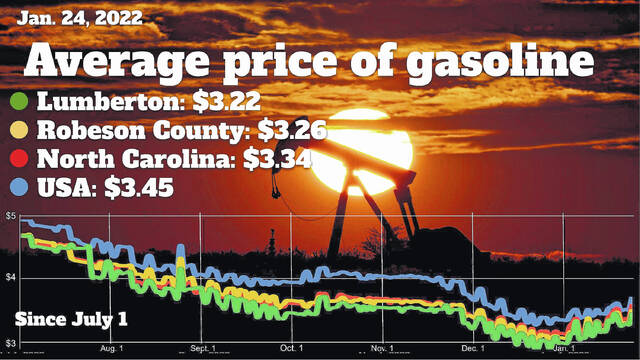LUMBERTON — Like the rest of the country, Robeson County saw another week of increasing gasolin prices.
On Tuesday Robeson County drivers were paying an average of $3.26 per gallon at local stations. In Lumberton proper, the average price of gas was slightly lower, $3.22 per gallon.
Tuesday marked the fourth straight week of increases around the county and around the country.
The nation’s average gas price has climbed, rising 11.3 cents from a week ago to $3.39 per gallon yesterday according to GasBuddy data compiled from more than 11 million individual price reports covering over 150,000 gas stations across the country.
While prices in the greater Robeson County area still remain 10-15 cents lower than most of the country, they follow the same trend.
The national average is up 30.2 cents from a month ago and 7.3 cents per gallon higher than a year ago. The national average price of diesel has risen 2.6 cents in the last week and stands at $4.60 per gallon, according to GasBuddy.
“Gasoline prices continued their upward trajectory last week as oil prices pulled them higher across the majority of the country, and continued refinery challenges kept supply of gasoline from rising more substantially,” said Patrick De Haan, head of petroleum analysis at GasBuddy. “Macroeconomic factors have continued to weigh on oil and refined products, as strong demand in China hasn’t been slowed much by a surge in new Covid cases. In addition, releases of crude oil from the Strategic Petroleum Reserve have wrapped up. Concerns are increasing that without additional oil, supply will tighten in the weeks ahead, especially as the nation starts to move away from softer demand in the height of winter. Moving forward, it doesn’t look good for motorists, with prices likely to continue accelerating.”
OIL PRICES
Oil markets continued their rally over the last week, opening the week in the black, with a barrel of West Texas Intermediate crude oil up 47 cents to $82.11 per barrel, a nearly $2 rise from last Monday’s $80.21 per barrel start.
Brent crude was also up in early Monday trade by 76 cents to $88.39 per barrel, a nearly $3 rise from last week’s $85.85 per barrel fetch.
Along with releases concluding from the Strategic Petroleum Reserve, China’s consumption continues to improve as it deviates on Covid, reopening its economy and loosening travel restrictions. In addition, a return to colder than normal weather conditions in areas of the U.S. may inspire a rise in heating oil consumption, and a weakening U.S. dollar is also likely piling in to put more upward pressure on oil.
According to Baker Hughes, last week’s U.S. rig count was down 4 rigs to 771 and was 167 rigs higher than a year ago. The Canadian rig count rose 14 to 241 and was 29 rigs higher than a year ago.
OIL AND REFINED PRODUCTS
Last week’s report from the Energy Information Administration showed another large build in U.S. oil inventories, as refiners remained affected by the Arctic blast from December.
Oil inventories jumped 8.4 million barrels, while the SPR saw no change in the last week. Domestic crude oil production held at 12.2 million barrels per day. Gasoline inventories perked up a modest 3.5 million barrels, but remain about 16 million barrels below the average for this time of year. Distillate inventories fell 1.9 million barrels and stand 12.2 million barrels lower from a year ago.
Implied gasoline demand, a proxy for retail consumption, rose 496,000bpd to 8.05 million barrels, just under GasBuddy estimates of 8.14 million. Refinery utilization saw some improvement, rising 1.2 percentage points to 85.3%, but will likely remain under pressure in coming weeks as turnarounds begin ahead of the spring and summer driving season.
FUEL DEMAND
According to GasBuddy demand data driven by its Pay with GasBuddy card, U.S. retail gasoline demand fell 1.4% last week (Sun-Sat) as demand plummeted in the Rockies, perhaps as prices skyrocket due to Suncor’s downtime. Broken down by PADD region, demand fell 2.3% in PADD 1, fell 1.4% in PADD 2, fell 2.2% in PADD 3, fell 8.3% in PADD 4, and rose 1.7% in PADD 5.
GAS PRICE TRENDS
The most common U.S. gas price encountered by motorists stood at $3.19 per gallon, unchanged from last week, followed by $3.39, $3.09, $3.29 and $3.49 rounding out the top five most common prices.
The median U.S. gas price is $3.32 per gallon, up 13 cents from last week and about 7 cents lower than the national average.
The top 10% of stations in the country average $4.23 per gallon, while the bottom 10% average $2.93 per gallon.
The states with the lowest average prices: Texas ($3.02), Oklahoma ($3.04) and Mississippi ($3.04).
The states with the highest average prices: Hawaii ($4.87), California ($4.36) and Washington ($3.90).








